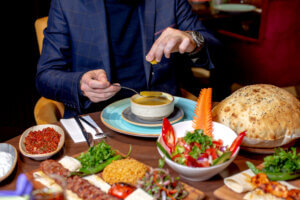Imagine a land where emerald hills roll like waves against the horizon, draped in a verdant sea of tea bushes. This is Sri Lanka, a country where tea is not just a beverage but a way of life. From the bustling streets of Colombo to the serene highlands of Nuwara Eliya, tea forms the backbone of Sri Lankan culture. Join me on a journey through this captivating island, as we explore the rich tapestry of Sri Lankan tea culture, from leaf to cup.
The Story of Sri Lankan Tea Culture Guide: From Leaf to Cup
The story of Sri Lankan tea, or Ceylon tea as it’s traditionally known, begins in the 19th century. In the wake of a devastating coffee blight, planters sought a new crop to cultivate. It was in 1867 that James Taylor, a Scottish planter, planted the very first tea estate in Kandy. Little did he know that this humble beginning would lay the foundation for one of the world’s greatest tea industries.
Over the years, tea has become an intrinsic part of Sri Lanka’s identity. Each region, from the misty hills of Nuwara Eliya to the lush lowlands of Ratnapura, contributes its unique flavor and aroma, painting a rich mosaic of tastes that captivates tea enthusiasts worldwide.
Key Elements
The magic of Sri Lankan tea lies in its simplicity and purity. The essential ingredients are:
- Camellia sinensis: The tea plant from which all tea varieties originate. The climate and soil of Sri Lanka impart a distinctive character to the leaves.
- Pure Water: The quality of water used in brewing greatly influences the final taste of the tea.
- Fresh Air and Sunshine: The island’s unique microclimates, with their misty mornings and sunlit afternoons, are vital to developing the tea’s flavor profile.
Preparation or Practice
Preparing a perfect cup of Sri Lankan tea is an art form, a ritual that engages all the senses. Picture this: early morning mists lingering over the tea estates as skilled hands pluck the tender two leaves and a bud, the finest pick for a premium brew.
Once harvested, the leaves are withered to reduce moisture, then rolled to release their delicate flavors. The oxidation process follows, where the leaves turn a rich, dark color, unlocking their full aromatic potential. Finally, they are fired to halt oxidation and lock in the flavors. Each step, from plucking to packaging, is overseen with meticulous care and a deep respect for tradition.
Symbolism or Local Meaning
In Sri Lanka, tea is much more than a drink; it is a symbol of hospitality and friendship. Offering tea to a guest is a gesture of warmth and welcome, a tradition that transcends social and economic boundaries. The act of sharing a cup of tea fosters a sense of community and connection, reinforcing the bonds that hold Sri Lankan society together.
Moreover, tea plantations are a testament to the island’s colonial past and its resilience in the face of change. They stand as a reminder of the ingenuity and perseverance of the Sri Lankan people, who transformed adversity into opportunity.
Where to Experience It
To truly immerse yourself in Sri Lankan tea culture, a visit to the heart of the tea country is imperative. Here are some must-visit places:
- Nuwara Eliya: Known as “Little England,” this picturesque town is home to some of the most famous tea estates. Take a guided tour of a tea factory to witness the intricate process of tea production.
- Ella: Nestled in the hills, Ella offers breathtaking views and an opportunity to explore the tea trails. Visit a local tea shop for a tasting session, where you can savor the diverse flavors of Ceylon tea.
- Kandy: The cultural capital of Sri Lanka, Kandy offers a blend of history and tradition. Don’t miss the Ceylon Tea Museum, where you can learn about the evolution of tea in Sri Lanka.
Tips for Travelers
When exploring Sri Lankan tea culture, keep these tips in mind to enrich your experience:
- Embrace Local Etiquette: Accepting a cup of tea when offered is a sign of respect and appreciation for the host’s hospitality.
- Seek Authentic Experiences: Visit family-owned tea estates and local tea shops to experience the genuine warmth of Sri Lankan tea culture.
- Be Mindful of Sustainability: Support tea brands that prioritize fair trade practices and environmental sustainability.
Conclusion
As you sip a steaming cup of Ceylon tea, let the flavors transport you to the lush landscapes and vibrant culture of Sri Lanka. Each sip tells a story of resilience, community, and tradition—a story that connects the past to the present, leaf to cup. Whether you are a seasoned tea aficionado or a curious traveler, the journey through Sri Lanka’s tea country promises to be a deeply enriching experience, one that leaves a lasting impression on your heart and taste buds alike.




